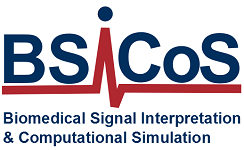-
Projects
PID2023-148975OB-I00: Sex as modulator of electrophysiological abnormalities leading to cardiovascular risk (HORMONECG)
Start date
2024
End date
2027
Coordinator
Julia Ramírez, Ana Mincholé
Funding agency
Agencia Estatal de Investigación
Cardiovascular diseases (CVD) account for 32% of global deaths, with an incidence significantly different in males and females. Mechanistically, sex differences have been observed in the context of ischemia, but also in channelopathies and cardiomyopathies, where males are at a higher risk. Thus, sex-specific tools for early identification of high-risk individuals are crucial for targeted prevention measures.
Differences in standard ECG markers between males and females can be observed in healthy and in CVD conditions, but the QT interval is the only ECG marker with established sex-specific thresholds for CVD risk currently applied in clinical practice. Hence, there is a need to establish sex-specific ECG waveform standards to optimise the interpretation and clinical validity of the ECG as a non-invasive predictor of CVD risk.
The lack of well-defined sex-specific ECG risk markers may be attributed to the presence of confounding demographic, anatomical, functional or autonomic factors that also manifest on the ECG waveforms. Disentangled representation learning is a recent artificial intelligence (AI) technology that enables the investigation of the influence of these confounding factors on the ECG morphology. Moreover, genomic studies and multiscale computational models of the human heart are extremely useful to investigate the electrophysiological changes that occur as a result of these factors, and their link with CVD.
Finally, menopause is a critical stage marked by significant hormonal changes, which have an independent impact on CVD progression. AI models classify sex using the ECG, and this classification correlates with both hormone levels and mortality, suggesting that the ECG could serve as a non-invasive tool for diagnosing, detecting, and predicting CVD risk and progression in females undergoing menopause.
The overall aim of HORMONECG is to identify electrophysiological differences between males and females that explain the gap in CVD prevalence and incidence in both groups using a non-invasive and widely available tool like the ECG signal. In addition, HORMONECG will investigate the mechanisms underlying these differences through a combination of data analysis, AI, computational simulation, and statistical genetics. To achieve this goal, HORMONECG will first develop a statistical atlas describing the distribution of ECG waveforms as a function of demographic, anatomical, functional, autonomic and hormonal factors and use it to correct the ECG morphology for their effect. Then, HORMONECG will establish sex-specific ECG signatures of risk in males and females without known CVD risk, and in ischemic- and non-ischemic conditions after correcting the ECG morphology to isolate the arrhythmogenic component. Finally, HORMONECG will identify the impact of hormone levels on the ECG in females before and after menopause and investigate both its association with CVD risk and its underlying mechanisms.
Results from HORMONECG are of the upmost importance to contribute to our understanding of the sex differences in CVD prevalence and incidence, to facilitate the development of more personalised tools able to optimise risk stratification and to understand the increased risk experienced by females as a result of menopause.
